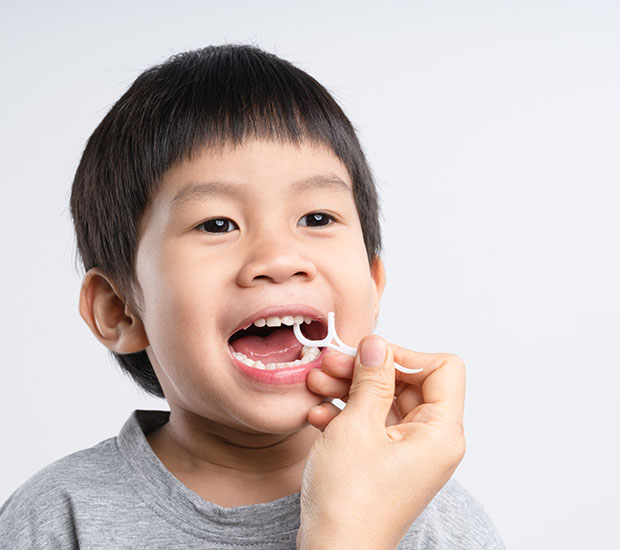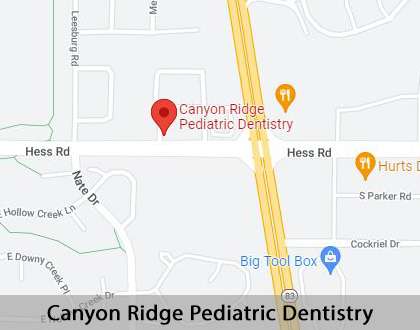How to Floss Your TeethParker, CO
Children should begin flossing as soon as they have two teeth that touch, at age two or three. They usually need help from caregivers until age eight to ten. Learning how to floss is key for maintaining good oral health. Flossing removes plaque and debris between teeth and under the gums that a toothbrush cannot reach.
Professional dental services, and advice on oral health, such as helping kids learn how to floss, are available at Canyon Ridge Pediatric Dentistry in Parker and the surrounding area. Call us at 303-841-7900 to learn more or schedule an appointment.
What Is Flossing?
Flossing involves removing food, plaque, and other debris from between the teeth and underneath the gums with dental floss. Plaque is the sticky or fuzzy film that consistently develops on teeth. The bacteria within plaque produces acid that can damage tooth enamel and cause gum disease and cavities. The plaque under the gums can damage the roots and bones supporting teeth. Plaque can also harden into tartar, which only a dentist can remove.
To reach the plaque between teeth and underneath your gums, we recommend flossing once a day. Flossing before brushing instead of after removes more plaque and allows the teeth to retain more fluoride from the toothpaste.
“Flossing involves removing food, plaque, and other debris from between the teeth and underneath the gums with dental floss.”
What Is Flossing?
Removing plaque is the most important benefit of flossing. Unremoved plaque hardens into tartar, which a dentist must remove. Tartar build-up requires longer dental cleaning sessions.
In addition to removing plaque, flossing helps prevent bad breath, gum disease, gum and tooth infections, cavities, and tooth decay. Learning how to floss correctly will provide maximum oral health benefits. Proper flossing is also more comfortable.
“In addition to removing plaque, flossing helps prevent bad breath, gum disease, gum and tooth infections, cavities, and tooth decay.”
How To Floss
Many flossing tools are available. Floss holders and pre-threaded flossers are helpful for patients who have limited dexterity or for children’s teeth while learning how to floss. Water irrigators or flossers can help in some situations, such as cleaning around braces, but they do not remove plaque.
Only dental floss will entirely remove plaque from under the gums and between the teeth. The two most common flossing methods are the loop or circle method and the spool or finger-wrap method.
The Loop Method:
- Cut a piece of floss approximately 18 inches long.
- Tie it firmly into a loop.
- Put all fingers inside the loop, leaving just the thumbs outside.
- Using your thumbs, guide the floss between each tooth. Bend the floss in a C-shape along the side of each tooth and below the gum line.
The Spool Method:
- Cut a piece of floss between 18 and 20 inches long.
- Wrap each end several times, not too tightly, around each of the middle fingers.
- Using your index fingers and thumbs, guide the floss between the teeth.
- Bend the floss into a C-shape, sliding up and down each tooth and under the gums.
“Only flossing with dental floss will fully remove plaque from under the gums and between teeth.”
Check out what others are saying about our dental services on Yelp: How to Floss Your Teeth in Parker, CO
How To Floss With Braces
Learning how to floss around braces takes practice. The archwire that connects each brace bracket blocks the path of dental floss halfway along with each tooth. For a completely clean smile dental floss must be threaded underneath the wire.
As dental floss is flimsy, most people with braces use floss threaders: needle-shaped tools with stiff points that easily target the narrow gap under the archwire.
How to use a floss threader:
- Run the floss threader under the archwire, point first.
- When the loop at the end passes halfway, thread a few inches of floss through.
- Floss teeth as usual.
- Repeat for all teeth.
Younger children with braces will need help flossing with braces, as they might not have the patience or coordination to do it properly. To help a child keep still while flossing, parents often have them watch TV or a video.
“As dental floss is flimsy, most people with braces use floss threaders: needle-shaped tools with stiff points that easily target the narrow gap under the archwire.”
Questions Answered on This Page
Q. What are the benefits of flossing?
Q. What is the best way to floss?
Q. What is the best way to floss with braces?
Q. What types of dental floss are available?
People Also Ask
Q. What is the proper brushing technique?
Types of Dental Floss
Types of dental floss include textured, smooth, flavored, wide, regular, waxed, ribbon, and string floss.
The effectiveness of dental floss depends upon how it is used. People will be more likely to floss daily and thoroughly if they use their preferred type of floss.
“How effective a type of dental floss is depends upon how you use it.”
Frequently Asked Questions
Q. Why is flossing important?
A. Toothbrushing cannot reach underneath the gums or between the teeth, leaving behind plaque. Accumulation of harmful bacteria damages teeth and gums. Plaque also hardens into tartar, which must be scraped off by a dental professional.
Q. Why is plaque bad for your teeth?
A. Plaque contains bacteria that secrete acid when you eat or drink. That acid can erode tooth enamel and lead to cavities. Bacteria under the gums can cause gum disease and infection. Learning how to floss correctly removes bacteria by removing plaque.
Q. What do parents of young children need to know about flossing?
A. Parents should know that children need to begin flossing whenever they develop two teeth that touch. Children that young often do not have the coordination or patience to floss independently, so parents should floss for them. When the child is between eight and ten, they may begin flossing independently.
Q. What tools should I buy for flossing?
A. Dental floss is the only tool most people need for flossing. Water picks or irrigators cannot remove plaque. People with limited dexterity can try floss holders or pre-threaded flossers, which are also helpful for children.
Q. How can I floss if I have braces?
A. People with braces often use floss threaders to help them floss thoroughly. Run the floss threader under the archwire, point first. When the loop at the end passes halfway, thread a few inches of floss through. Young children with braces may require an adult’s help or supervision.
Quality Pediatric Dental Services Can Transform Smiles
By visiting us as soon as possible, our team can help get your child the professional treatment they need.
Definition of Pediatric Dental Terminology
Learn More About Flossing
Learning how to floss leads to good oral hygiene. Children should begin flossing as soon as they have two teeth that touch each other. Flossing at least once a day before brushing will remove hidden plaque and bacteria.
If you are looking for pediatric dental care, let Canyon Ridge Pediatric Dentistry in Parker help. Call us at 303-841-7900 to learn more about our services and policies.
Helpful Related Links
- American Dental Association (ADA). Glossary of Dental Terms. 2023
About our business and website security
- Canyon Ridge Pediatric Dentistry was established in 2012.
- We accept the following payment methods: American Express, Cash, Check, Discover, MasterCard, Paypal, and Visa
- We serve patients from the following counties: Douglas County
- We serve patients from the following cities: Parker, Centennial, Castlewood, Southglenn, Castle Rock, and Highlands Ranch
- Healthgrades. View Background Information and Reviews
- Norton Safe Web. View Details
- Trend Micro Site Safety Center. View Details
Back to top of How to Floss Your Teeth







